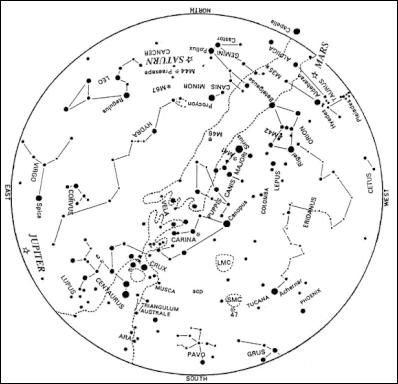The Night Sky
The Night Sky
Carter Observatory
The National Observatory Of New Zealand
The
March Night Sky
We are moving into Autumn now with the Sun visible for half the day. This means that the nights for astronomy are rapidly getting longer.
Planets
March is a good month for viewing the planets. Venus, Mars, Jupiter and Saturn will be visible for the whole of the month. Mercury will be visible for the last half of March.
Mars will be visible for the first third of the night. At the start of the month it sets at 23:35 and at 21:39* by month’s end. Mars is in the constellation of Taurus. Its magnitude fades from 0.7 to 1.2 during the month.
Saturn will be visible for the first two thirds of the night. At the start of March it sets at 04:10 and at 01:07* by month’s end. Saturn is in the constellation of Cancer, in which it remains until September 2006. Its magnitude slightly fades from –0.1 to 0.1.
Jupiter will be visible for all but the start of the night. At the start of the month it rises at 22:49 and by month’s end at 19:48*. Jupiter is in the constellation of Libra, in which it remains until December 2006. Its magnitude slightly increases from –2.2 to –2.4 during the month.
Venus will be visible for the last quarter of the night. At the start of the month it rises at 03:35 and at 02:42* by month’s end. Venus starts the month in the constellation of Sagittarius, moving into Capricornus on March 7, into Aquarius on March 22 and back into Capricornus on March 28. Its magnitude fades from –4.6 to –4.3 during the month.
Mercury will be visible in the morning sky for the last half of the month. By March 13 Mercury rise at Sunrise, by March 19 at 05:24* (an hour before Sunrise) and at 04:26* by month’s end. It starts the month in the constellation of Pisces, moving into Aquarius on March 19. Its magnitude rapidly increases from 4.8 on March 13, 2.7 on March 19 and 0.8 by the end on March.
All times are for Wellington unless otherwise stated. Other centres may vary by a few minutes.
*Time corrected for the change from New Zealand Daylight Time (NZDT) to New Zealand Standard Time (NZST).
Phases of the Moon
First Quarter – March 7 at 09:16.
Full Moon – March 15 at 12:35.
Last Quarter – March 23 at 07:11.
New Moon – March 29 at 22:15.
New Zealand Daylight Time Ends
Time changes from New Zealand Daylight Time (NZDT) to New Zealand Standard Time (NZST) on the morning of Sunday, March 19, at 02:00. Clocks and watches need to be put back by one hour so we will then be 12 hours ahead of Universal Time (UT). It means we get an extra hour in bed but unfortunately the light evenings are shorter.
Autumnal Equinox
The Southern Hemisphere Autumnal Equinox occurs on March 21 at 06:26. This is when the Sun moves from the Southern Hemisphere into the Northern Hemisphere.
Diary of Astronomical Phenomena
Mar 2 Mercury
stationary against the background stars at 20:00, as its
motion changes from an Easterly to a Westerly
direction.
5 Jupiter stationary against the background
stars at 13:00, as its motion changes from an Easterly to a
Westerly direction.
6 Mars close to the Moon soon after
Sunset.
12 Mercury in inferior conjunction (between the
Earth and the Sun) at 16:00.
13 Moon at apogee (furthest
from the Earth) at 15:00 (Distance = 0.0027158 AU = 406,280
km).
15 Full Moon at 12:35.
18 Spica very close to the
Moon at 00:00. Spica (alpha Virginis) is a blue star at a
distance of 250 light years.
20 Jupiter 5°N of Moon at
02:00.
21 Autumnal Equinox at 06:26.
25 Mercury
stationary against the background stars at 00:00, as its
motion changes from a Westerly to an Easterly
direction.
25 Venus at greatest Westerly elongation from
the Sun (47) at 19:00.
28 Mercury 2°N of Moon at
05:00.
28 Moon at perigee (closest to the Earth) at
19:00. (Distance = 0.0024009 AU = 359,170 km).
29 New
Moon at 22:15.
MARCH SKY CHART
This chart shows the sky as it appears at about 22:00 for March (21:00 after March 18).

Click for big version
How To Use the Sky Charts
To use the sky chart hold it up to the sky so that the direction in which you are looking is at the lower edge of the map. For example, if you are looking at the western horizon then the map should be held so that the “WEST” label is at the lower edge. The altitude and direction of the stars and planets will then be correctly shown. The centre of the chart will be directly overhead.
* Brian Carter is the Senior Astronomer at Carter Observatory (The National Observatory of New Zealand), PO Box 2909, Wellington. (Email: Brian.Carter@Carterobs.ac.nz , Observatory Web Site: www.CarterObservatory.org )


 Eugene Doyle: The Fall Of Saigon 1975 - Fifty Years Of Repeating What Was Forgotten
Eugene Doyle: The Fall Of Saigon 1975 - Fifty Years Of Repeating What Was Forgotten Peter Dunne: Dunne's Weekly - Trump's Tariffs Still Pose Risks For New Zealand
Peter Dunne: Dunne's Weekly - Trump's Tariffs Still Pose Risks For New Zealand Keith Rankin: Barbecued Hamburgers And Churchill's Bestie
Keith Rankin: Barbecued Hamburgers And Churchill's Bestie Gordon Campbell: On Why The US Stands To Lose The Tariff Wars
Gordon Campbell: On Why The US Stands To Lose The Tariff Wars Eugene Doyle: Before It’s Too Late - Reimagine New Zealand’s Military Future
Eugene Doyle: Before It’s Too Late - Reimagine New Zealand’s Military Future  Binoy Kampmark: Gender Stunts In Space - Blue Origin’s Female Celebrity Envoys
Binoy Kampmark: Gender Stunts In Space - Blue Origin’s Female Celebrity Envoys